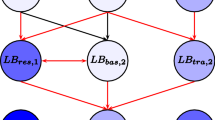Abstract
This investigation considers a reentrant permutation flow-shop (RPFS) scheduling problem whose performance criterion is makespan. A reentrant flow-shop (RFS) refers to situations in which every job must be processed on machines in the order, M 1, M 2, ..., M m , M 1, M 2, ..., M m , ..., and M 1, M 2, ..., M m . Every job can be decomposed into several layers each of which starts on M 1 and finishes on M m . In the RFS case, if the job ordering is the same on any machine at each layer, then no passing is said to be allowed, since no job is allowed to pass any former job. The RFS scheduling problem in which no passing is allowed, is called an RPFS problem. A branch and bound algorithm is presented and an example is also given to illustrate the solution procedure. To compare the proposed algorithm, a series of computational experiments are done on randomly generated test problems and the results show that the developed algorithm is efficient.
Similar content being viewed by others
Abbreviations
- n :
-
Total number of jobs for processing at time zero
- m :
-
Total number of machines in the shop
- L :
-
Total number of levels of each job
- J i :
-
Job number i, 1≤i≤n
- J i(q) :
-
Job scheduled at the qth position in the processing sequence, 1≤q≤n
- M k :
-
Machine number k, 1≤k≤m
- O lk i :
-
Operation of J i on M k at layer l, 1≤i≤n, 1≤l≤L, 1≤k≤m
- P lk i :
-
Processing time of O lk i, 1≤i≤n, 1≤l≤L, 1≤k≤m
- C lk i(q) :
-
Completion time of J i(q) on M k at layer l, 1≤q≤n, 1≤l≤L, 1≤k≤m
References
Wang MY, Sethi SP, Van De Velde SL (1997) Minimizing makespan in a class of reentrant shops. Oper Res 45:702–712
Bispo CF, Tayur S (2001) Managing simple re-entrant flow lines: theoretical foundation and experimental results. IIE Trans 33:609–623
Uzsoy R, Lee CY, Martin-Vega LA (1992) A review of production planning and scheduling models in the semiconductor industry Part 1: system characteristics, performance evaluation and production planning. IIE Trans 24:47–60
Kubiak W, Lou SXC, Wang Y (1996) Mean flow time minimization in reentrant job-shops with a hub. Oper Res 44:764–776
Pan JCH, Chen JS (2003) Minimizing makespan in reentrant permutation flow-shops. J Oper Res Soc 54:642–653
Pinedo M (2002) Scheduling: theory, algorithms, and systems. Prentice-Hall, Engelwood Cliffs, NJ
Ignall E, Schrage L (1965) Application of the branch and bound technique to some flow-shop scheduling problems. Oper Res 13:400–412
Lomnicki ZA (1965) A “branch-and-bound” algorithm for the exact solution of the three-machine scheduling problem. Oper Res Q 16:89–100
McMahon GB, Burton PG (1967) Flow-shop scheduling with the branch-and-bound method. Oper Res 15:473–481
Ashour S (1970) A branch-and-bound algorithm for flow-shop scheduling problems. AIIE Trans 2:172–176
Gupta JND (1971) An improved combinatorial algorithm for the flow-shop scheduling problem. Oper Res 19:1753–1758
Baker KR (1975) A comparative study of flow-shop algorithms. Oper Res 23:62–73
Townsend W (1977) Sequencing n jobs on m machines to minimize maximum tardiness: a branch-and-bound solution. Manag Sci 23:1016–1019
Lageweg BJ, Lenstra JK, Rinnooy Kan AHG (1978) A general bounding scheme for the permutation flow-shop problem. Oper Res 26:53–67
Bansal SP (1979) On lower bounds in permutation flowshop problems. Int J Prod Res 17:411–418
Potts CN (1980) An adaptive branching rule for the permutation flow-shop problem. Eur J Oper Res 5:19–25
Gupta JND, Shanthikumar JG, Szwarc W (1987) Generating improved dominance conditions for the flowshop problem. Comput Oper Res 14:41–45
Campbell HG, Dudek RA, Smith ML (1970) A heuristic algorithm for the n job, m machine sequencing problem. Manag Sci 16:B630–B637
Nawaz M, Enscore EE, Ham I (1983) A heuristic algorithm for the m-machine, n-job flow-shop sequencing problem. Omega 11:91–95
Author information
Authors and Affiliations
Corresponding author
Rights and permissions
About this article
Cite this article
Chen, JS. A branch and bound procedure for the reentrant permutation flow-shop scheduling problem. Int J Adv Manuf Technol 29, 1186–1193 (2006). https://doi.org/10.1007/s00170-005-0017-x
Received:
Accepted:
Published:
Issue Date:
DOI: https://doi.org/10.1007/s00170-005-0017-x




